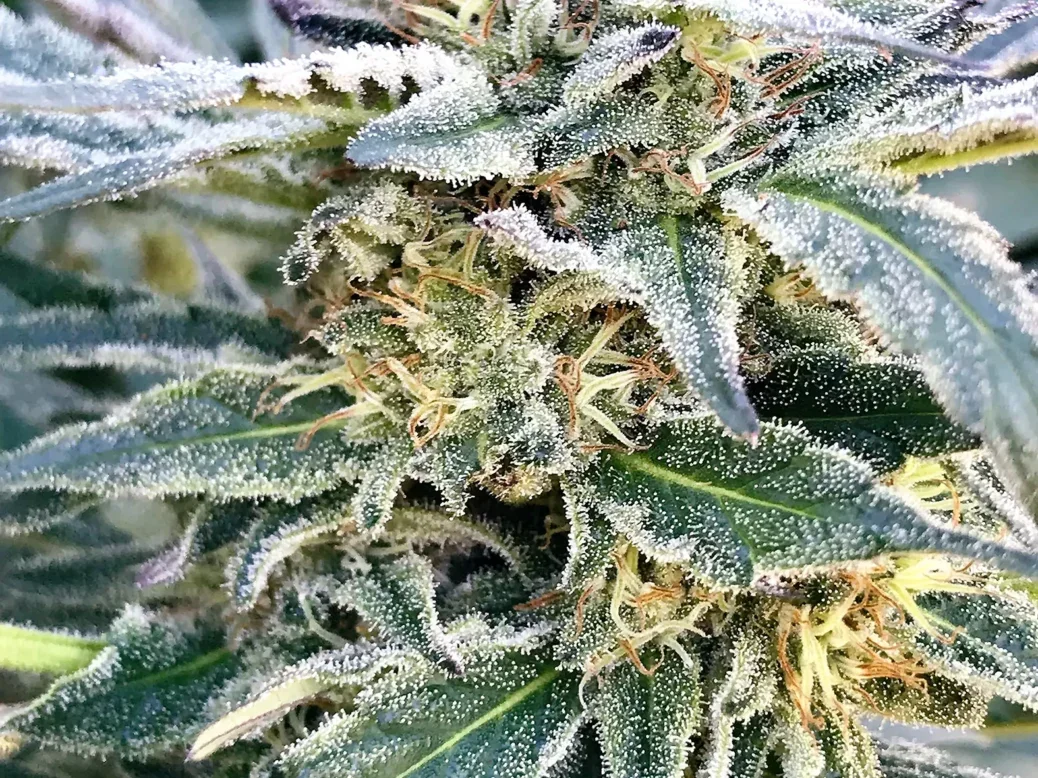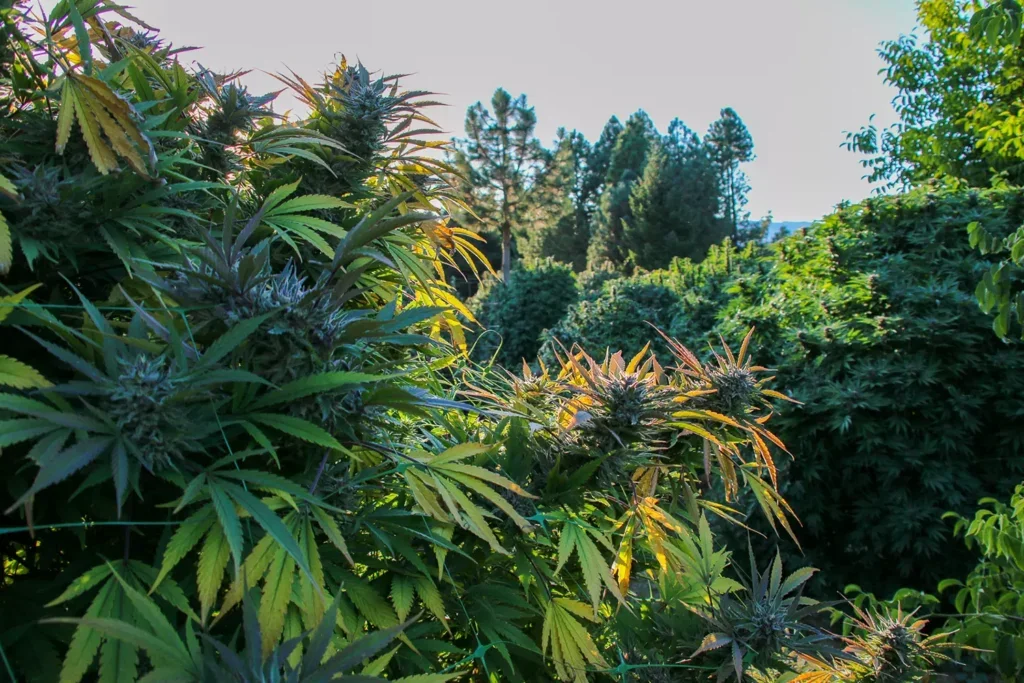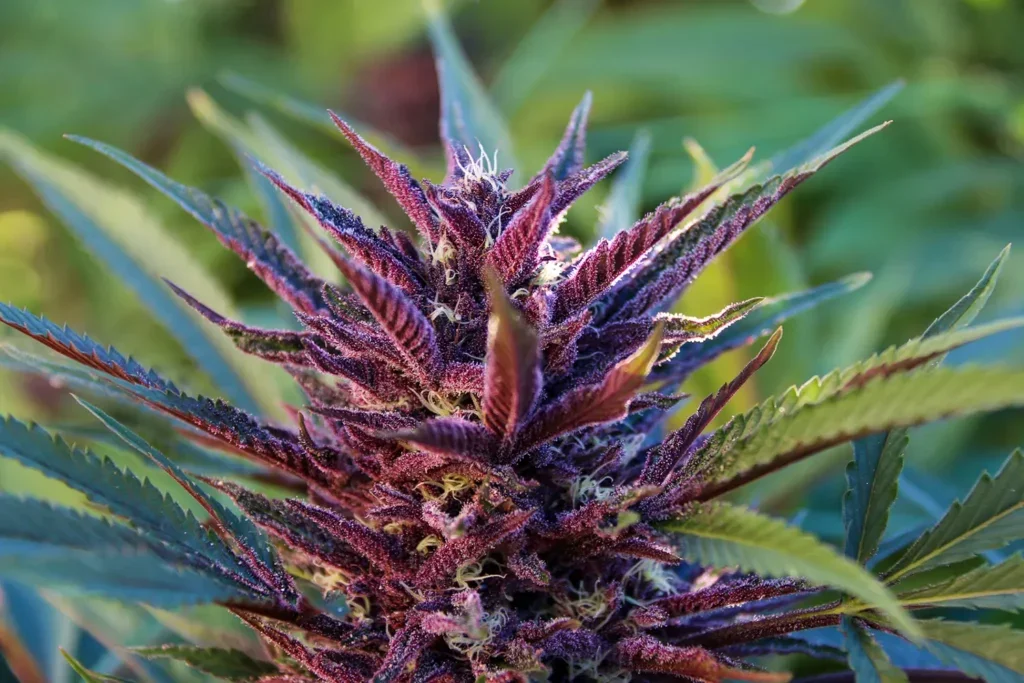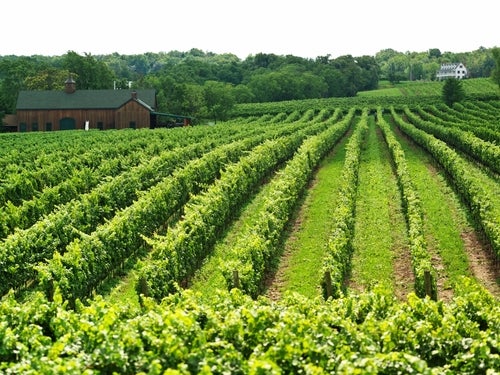
With cultivation and consumption now legal in many US states, cannabis is leaving its illicit past behind. But is weed ready for the same connoisseurial approach as wine? Jim Clarke reports from California
Willits, Ukiah Valley, Comptche, Porter Valley—these are just a few of the new appellations that have been proposed for California’s Mendocino County. They aren’t AVAs (American Viticultural Areas), nor do they represent an explosion of new vineyards in the county, which lies just north of Sonoma (and is indeed home to some remarkable vineyards, most notably in the Anderson Valley). Rather, these and seven other areas appear on a much-circulated map illustrating a hypothetical but plausible map of cannabis appellations.
The United States federal government still considers cannabis a controlled substance, but that hasn’t stopped a number of states from legalizing it on medical grounds and, increasingly, for recreational use. California led the way with the former in 1996 and opened the door for recreational use exactly 20 years later. But cannabis farming in the state has deeper roots, particularly in the north.
“We are in what’s known as the Emerald Triangle,” says Bret Clarke, founder of Bandwagon Gardens (and my brother), who has been growing cannabis in Humboldt County, north of Mendocino, for 25 years. “That’s Humboldt, Trinity, and Mendocino counties. People have been growing weed in this area since the late ’60s.”
Humboldt County alone was believed to be the source of half the US’s cannabis in the 1980s. It is the growers in these regions who have led the push for a system of cannabis appellations—an effort that in its earliest forms even predates the legalization of recreational cannabis use by a year.
Until this year, three different California state governmental agencies oversaw cannabis production and sales, most notably the California Department of Food and Agriculture, and regulations had been developed piecemeal via several different state bills. In 2018, a state statute mandated the creation of an appellations program, and after a great deal of research, it was set to roll out this year. In the meantime, however, the state has consolidated oversight of the cannabis industry into one organization, the newly formed Department of Cannabis Control, and the new agency is in the process of streamlining and reconciling all the various regulations, licensing, and other activities formerly being handled independently. Once that process is completed, the department is expected to open the door to petitions for officially recognized cannabis appellations.
The primary organization behind that push is the Origins Council, which grew out of the Mendocino Appellations Project; its overall mission focuses on creating sustainable rural economic development in historic cannabis growing regions, and the establishment of standards-based geographical indications for cannabis are a major part of that effort.
“We’re representing specifically historic cannabis-producing regions, multigenerational farms, and farming families,” says founder and executive director Genine Coleman. “In the context of cannabis licensing, regulation, and legalization, this issue is by far the most farmer-driven movement.”
At the individual level, these “legacy growers” are inherently small operators; several years ago, California instituted regulations intended to limit growers to a single acre of land (0.4ha), and according to Coleman, plots as small as a quarter-acre (0.1ha) are typical. That was set to change and open the door to larger farms in 2023, but that dog is already off the leash; loopholes and lax enforcement in some counties mean that farms of 80 acres (32ha) or more are already operating. Santa Barbara County in particular allowed farms over one acre in size to be grandfathered in as exempt from the one-acre maximum, without documentary proof of a history of cannabis production. In 2019, the Los Angeles Times reported, “Farms in Santa Barbara County hold 35% of all cultivation licenses issued in California this year, despite the county having only 1.8% of the state’s land. Humboldt County, the historic center of the marijuana universe, has 22%, while illegal grows there continue to dominate the larger black market.”

Several other states, where legacy growers are either nonexistent or too few to have a voice, have not placed similar limitations on size; Colorado, Arizona, Nevada, and Oklahoma are home to sizable farms. Interstate shipping of cannabis is technically illegal under federal law, so California’s legacy growers are insulated from that additional market competition for now, at least.
Compared to vineyards, these legacy growers may sound too minuscule to be viable businesses; by comparison, the average Bordeaux estate has about 50 acres (20ha) of vineyards. But the ratio of output volume compared to the typical unit of sale is vastly different for marijuana. My brother’s farm is almost a half-acre (0.2ha) in size and produces between 1,200 and 1,500 pounds (544–680kg) of usable cannabis in a typical year. The usual amount for an individual purchase—something vaguely comparable to a 75cl bottle in the world of wine—is an eighth of an ounce (3.5 grams; cannabis has a maddening tendency, at least in the US, to shift between imperial and metric measurements). In terms of serving size, probably the closest analog we’ll get to a “glass” of wine would be the one-gram joint, but joints themselves are often shared. According to some generous, back-of-the-envelope math, in a good year my brother’s farm yields 192,000 “eighths”—that is, wine-bottle equivalents—of cannabis. An 80-acre cannabis farm would, with the same yields, produce over 30 million eighths, or more than 100 million joints.
Obviously, the bigger farms will have a much larger market presence and heft than any individual legacy grower, and the hope of the Origins Council is that an appellation system will provide legacy growers a marketing tool that will allow them to continue to compete and command a higher price for their product via collective branding. The need is dire; the large number of new entrants and the growth of large farms has had a massive negative impact on prices already, driving them down to just one third what they were a year ago. Many legacy farmers are breaking even at best, and some are leaving the industry. In fact, that sudden price drop has slowed the conversation on appellations as advocates address more immediate concerns, including relief from the extremely high taxes faced by cannabis. During legalization, almost every portion of the government saw cannabis taxes as an answer to budget shortfalls, and by one estimate the various taxes on cannabis total out to $161 per pound (450g) in California. These taxes and the onerous paperwork have encouraged a thriving illegal trade that creates additional competition for legitimate legacy growers.
A human element to terroir?
Because the motivation behind creating a cannabis appellation system was inspired by a desire to help these growers, early conceptions of a such a system sought to emphasize the human story. It’s not an unheard-of idea in the world of wine, where definitions of terroir can range from a rather literal-minded approach centered on soils, to a conceptually broad understanding wherein the human element—ideally represented by generations of perceived or genuine tradition—merits inclusion, the argument being that a people’s presence over decades, or more likely centuries, is therefore as much part of the place as the soils, the water, and the wind.
There was also hope among some cannabis appellation advocates that including a so-called human factor among the requirements could keep the larger, new entrants to the industry at bay. At the very least, they imagined that tying the story of an appellation’s pioneer growers would highlight them over latecomers. But some seem to have dreamed that it could even exclude the latter from making use of appellations entirely.
There are a number of reasons why that would have proved untenable, but underlining the human element in the definition of a cannabis appellation could also have resulted in the creation of appellations with no ties to the natural environment whatsoever. In Southern California, cannabis is often grown indoors under powerful lamps. While someone familiar with the wine world’s concept of terroir would obviously scoff at suggesting something grown in a pot indoors could manifest a quality and character unique to its geographical location, Los Angeles growers, subject to the same market pressures as outdoor growers in the northern half of the state, did not want to be left out, and their argument for inclusion hinged in large part on the inclusion of the human element as a factor of terroir. These indoor growers claimed that their experience and history made their products valid expressions of terroir even if environmental forces didn’t play a part.
“Adopting a terroir-based appellation system was the most contentious point of the process,” says attorney Omar Figueroa, “because there are a lot of growers using mixed light, greenhouse, or artificial light who thought their products were entitled to appellation protection. They felt it was too stringent to exclude them by making sure that everything was in the ground and in open air, exposed to the elements. But from a terroir perspective, that’s not a bug; it’s a feature.”

Figueroa has been on the front lines of cannabis law and regulation for more than 20 years. He’s currently working on an application for the would-be Palo Verde appellation, a region right at the heart of the Emerald Triangle, where the three counties meet. “They have such a compelling story. It started out as volunteer department firefighters who were also cannabis growers in this remote area. They were rendering mutual assistance, developing close bonds protecting their community, and growing cannabis. We thought that was going to be the centerpiece of the appellation petition, but when the human factor was de-emphasized, it went from being the centerpiece to an interesting historical aside.”
From an international perspective, allowing indoor-grown cannabis would have made the appellation system a laughingstock, and the California government rejected the idea. As written, an appellation petition only needs to demonstrate that there is a history of cannabis growing in the region—one substantial enough to have demonstrated a “causal link” between the environment and the quality and character of the cannabis grown there. “There was some recognition on the part of the French agricultural ministry regarding the shape of the program here in California,” says Coleman, “speaking to the merit of it relative to their approach to appellation, and that was a great sort of endorsement that we’re hitting the mark.”
The line between indoor and outdoor is not clear cut. Cannabis plants begin to bud when their daily sunlight exposure drops below 12 hours. It’s common for growers in some areas to use light deprivation to stimulate bud development, placing sacks over plants for part of the day to lessen their sun exposure and thereby stimulate budding. By using “light dep,” a grower can go through two or even three harvests (“runs”) in a season rather than just one. When one only has half an acre to work from, this can be an economic necessity to increase volume—my brother uses a portion of his farm to grow light-dep cannabis, for example, in addition to his fully outdoor plantings. Light dep, like lamps, has been deemed too much a manipulation of the plant’s natural environment, and light-dep cannabis does not qualify for an appellation. The only permissible use of artificial light for appellation-bearing cannabis is for the propagation of immature plants; aside from that, natural sunshine is the rule. Greenhouses and the like are similarly forbidden.
A bone of sorts has been thrown to indoor and light-dep growers. Thanks to state Senate Bill SB-67, passed in 2020, cannabis products will be able to carry indications of geographical origin in the form of “City of Origin” or “County of Origin” (or, in the case of San Francisco, where those two entities are contiguous, “City and County of Origin”) designations, with borders conforming to those of existing municipalities and counties. These designations are distinct from the yet-to-be-created appellations and, unlike “proper” appellations, will apply to all cannabis grown within a city or county, regardless of growing technique—indoor, outdoor, and light dep alike.
Regulations also allow these City and County of Origin designations to be used on all cannabis products—vaping concentrates, edibles, and so forth—whereas for now at least the appellations will be confined to cannabis in its pure form. This seems to present a hurdle in terms of educating consumers about cannabis appellations. Given their pre-existent nature, City and County designations are likely to be far more familiar to consumers, at least at first; appellation supporters may be facing an uphill battle to raise consumer awareness of the appellation before they’ll be able to profit from it.
Cannabis terroir, quality, and character
Cannabis is an extremely youthful industry, and its lack of legal standing means scientific research has been limited for some time. But the shared experience of growers has convinced the state of California that there is a relationship between terroir and cannabis quality and character. It’s up to petitioners to articulate that relationship in their appellation applications. “It’s a very traditional path they’re pursuing,” Coleman says of the petition process. “This was really set in statute; the industry and our program led the way to advocate for a very traditional, Old World European model, whereby an appellation is granted on the evidence in the petition that the environmental influence of the region is causing a regionally distinct expression in the product, so there’s a causal link. Therefore, the agency is working to ensure that they have the expertise in place to really field and review petitions prior to launching the program.”
Accordingly, a petition to create a cannabis appellation, as per the new regulations, “shall describe each distinctive geographical feature affecting cannabis cultivation of the proposed appellation of origin” and goes on to list a number of elements deemed relevant. Climatic conditions are key: temperatures, humidity, fog, precipitation, aspect, and exposure are all explicitly called for in petitions, as are watersheds and irrigation sources. “If you think about where cannabis started,” Bret says, “it’s the Hindu Kush Mountains, northern Pakistan, Afghanistan… It’s hot, dry days, and then cool nights. It’s been shown you can grow great herb in this part of Northern California because you get those hot days and cooler nights. Extreme heat, like a lot of days over 100 degrees [Fahrenheit, 38°C] without cooling takes away from the quality. You’ll get more production, but it’s a lot for the plant to take. The differences that come in out here are elevation and proximity to the coast. I’m an advocate for high-elevation herb; the yields aren’t as good, but I find the quality is better. Moisture is worse for some strains than others, but it can be a real killer”—a factor that often deters cannabis growing closer to the ocean.
One glaring omission in the application requirements, at least from a wine aficionado’s point of view, is that soil types are not considered. “Most cannabis is grown in pre-made soils mixes in raised beds,” says Bret, who typically makes his beds with a mix of native and prepared soils. “That being said, there is a movement starting where people are growing in the native soil, and there are even farms that are doing dry-farming.” Growing in any soil whatsoever is already a big step up over indoor growers, the vast majority of whom use rockwool slabs and liquid potassium salt fertilizers to grow cannabis hydroponically.
On the other hand, those who consider organic growing to be truer to the terroir will be well satisfied. “We have the strictest pesticide regulations of any industry,” Bret says. “All our pesticide is all organic. I’d like to see all the food brought up to the same standard.” There are a few reasons; the product is after all inhaled directly into the lungs and is barely processed at all before it goes to the consumer. (“Curing” cannabis is mostly a matter of air-drying.) In addition, many legacy farms lie in remote locations in the middle of old-growth forests. In some areas, these strict rules have already created some distress among wine growers and other farmers who could face liability concerns should their own pesticides drift into neighboring cannabis farms.
Every agricultural product has preferred growing conditions, of course, but for many commodities, differentiating among geographical sources is minimally rewarding, at best. Ideally the product should demonstrate an ability to command a wide range of prices. Cannabis users have demonstrated a willingness to pay more for perceived quality, but unfortunately for growers of outdoor, sun-grown cannabis, geographical source is not yet the prime price determinant.
In an ironic twist, at the retail level, indoor cannabis actually commands the highest prices at the moment; protected, as it is, from the elements, it grows even, beautiful, unblemished buds. “The price range is huge,” my brother says. “To me and a lot of growers around here, it’s silly that indoor cannabis is considered top-shelf. A lot of us think that indoor just isn’t as good—I find a lot of indoor herb is very harsh on your throat—but the thing is, it looks amazing. Once you break it down and roll it in a joint, I don’t see how the looks have anything to do with it. You might spend $80–100 for an eighth of indoor-grown cannabis. That is the top, and you could go down all the way to where you’re getting a full ounce for $50.”
Aside from its appearance, there is also a lingering belief that indoor-grown cannabis is stronger. Concentrations of THC (tetrahydrocannabinol, the main psychoactive ingredient in cannabis) can vary widely, but differences largely hinge on the strain planted, not on the growing technique. Girl Scout Cookies, a popular strain, has been shown to reach THC levels as high as 28 percent, whereas many cultivars might typically come in closer to 10 percent or even lower. However, cultivars high in THC are low in CBD (cannabidiol), a non-psychoactive compound that, aside from recently becoming popular for its own purported health benefits, also protects the plants from some insect pests. So, it may be that historically it has been easier for growers to work with such cultivars in indoor, pest-free conditions.
Expanded legalization means cannabis is coping with a huge influx of novice consumers, for whom appearance or strength may be easily understood purchasing motivators. (Most observers actually recommend new users avoid high-potency strains like Girl Scout Cookies until they have a better understanding of their own tolerance of and reactions to THC.) Figueroa is confident that quality will show through as consumers have more chances to explore. “As consumers become better educated, they’re naturally going to gravitate towards outdoor. I can tell you as a cannabis consumer, when I was first introduced to cannabis on the East Coast when I was at Yale, there was a lot of brick weed [cannabis, typically of low quality, pressed into blocks for ease of transport], and it wasn’t that appealing. And then when I came to Stanford for law school, my God, the level of quality was several orders of magnitude better, and it was all Northern California bud. It was just a revelation. Consumers’ eyes will be opened to the wonders of outdoor cannabis in just the same way that people went from drinking cheap table wine to becoming refined connoisseurs.”

Connoisseurship of cannabis and wine
As with wine, connoisseurship in this case includes an appreciation of aromas, flavors, and mouthfeel—the aesthetics of the user’s experience. “It’s like eating good food or drinking a glass of fine wine: The flavor is what’s enjoyable,” says Bret. “Some have a really lemony smell. There’s a bunch that are called ‘gassy,’ which is a kind of astringent smell that’s very popular. You have that famous skunk bud that, yeah, smells like skunk. My favorite thing about legalization on a big level is the amount of different strains and flavors out there. It’s pushing people to grow their best and breeders to come up with really interesting things.” Leafly.com, a popular retail website, says the Girl Scout Cookies strain “is famous for its dessert-like flavor and aroma profile featuring bold notes of mint, sweet cherry, and lemon.”
While the language for describing cannabis obviously embraces terms familiar to wine drinkers, it also includes plainer talk on the psychoactive effects of the product as well. The physiological reaction induced by the mix of THC, CBD, and other cannabinoids found in the plant vary widely depending on their relative proportions—far more so than with wine, where alcohol is the only active ingredient (and that’s setting aside the variation among individuals based on their own tolerances, experience, and so forth). Descriptions of strains are consequently fairly straightforward in detailing the high they can be expected to provide. While in most countries wine and other alcoholic beverages are forbidden by law to advertise their inebriating qualities, it is usual with cannabis to explicitly outline the effect, on the mind and body, of the strain being offered.
Some strains, in particular those from the sativa subspecies, tend to create more euphoric reactions, while those from the other major subspecies, indica, tend to be more sedative. A great many strains are hybrids falling somewhere between those two. One can search through the catalog of different strains on Leafly.com by subspecies, the feeling induced, preferred flavors or aromas, terpenes, or medical condition it’s believed to help remedy. One can also then filter out undesirable negative effects such as paranoia or dry mouth, if one is particularly prone to them. There is also a significant number of cannabis consumers who are not only novices, with limited knowledge of the range of expression it offers, but who may be coming to cannabis solely for pain relief or other medical reasons, with no expectations of aesthetic enjoyment. The legalization of marijuana for medical use has pushed the vocabulary employed in describing the smoking experience in a direction perhaps not truly scientific but, in any case, decidedly less poetic or metaphorical than that of wine.
As with wine, again, the variety—strain, in this case—is largely responsible for the character of the consumed product, or at least with the potentialities of its character, and has become the primary piece of labeling information for buyers. The names range from fun—aside from the aforementioned Girl Scout Cookies, there’s Gorilla Breath, Sour Diesel, and Ice Cream Cake—to more classic monikers in the case of older strains like Afghany, OG Kush, or Durban Poison. (The latter two are Girl Scout Cookies’ parents.)
Like grapes, cannabis does not grow true to seed, and propagation by cuttings is necessary to guarantee a consistent genetic profile. There are more than 700 known strains in existence, with new strains—sometimes proprietary to a grower and even patented—introduced all the time. As a consequence of cannabis’s relatively long life as a contraband plant, there are probably many more that remain undocumented. A few people in the industry such as the Canndor Herbarium are attempting to catalog what’s out there in a systematic manner, but the world of cannabis strains is very much the Wild West.
The long-term fate of cannabis appellations
At this point, the conversation about cannabis appellations focuses mostly on which areas produce high-quality cannabis, but with very little detail on how cannabis from those different areas will express itself in terms of style or character. Which is very much how it should be, for now. Given the relative youth of the cannabis industry, and the growing multitude of different strains through which each terroir could be expressed, it seems like an enormous process of sifting will need to take place before one can start definitively associating particular strains with specific regions or make reliable statements of typicity for a growing area.
But some practical matters already push certain strains toward certain areas—for example, sativa strains have a longer growing period, so in places where that isn’t possible, indica strains are favored. In addition, cannabis is planted anew each year, so unlike grapes, which require several years before they even yield usable fruit, a cannabis grower can experiment with new strains each year. Of course, they can use this power for good—faster research to determine the strain best suited to their terroir—or ill, replanting the latest, trendy strain each year even when it may not be as suitable.
The long-term fate of cannabis appellations will probably hinge on when and, especially, how the federal government legalizes the drug. “There’s a long road ahead of us,” says Coleman. “In the context of trademarks, there were some proposed language and regulatory guidelines regarding conflicts with geographic trademarked names should an appellation be established with the same name, but that doesn’t speak to federal trademarks. We’ve got an interesting journey ahead of us because the United States is really not very GI [geographical indicator] friendly; they’re much more trademark-oriented.”
Coleman says they hope to get other states on board with their program—similar efforts are growing in Oregon—in the hopes that interstate agreements will establish a precedent for federal acknowledgment. Legalization at the federal level could then open the door for international protections as well.
“Appellations of origin don’t cost the government a lot of money,” Figueroa says, “and they add a lot of value once the appellation becomes known.” Wine brands have certainly seen an increasing demand from wine drinkers for stories, which may stand cannabis appellations in good stead. Though it may not have been part of the Palo Verde appellation petition, stories like those of its cannabis-growing firefighters will surely resurface to draw the attention and interest of consumers. But becoming known is the next challenge.
Coleman quotes Origins Council’s adviser Richard Mendelson, an expert on wine law who has shepherded a number of AVAs into being: “Many AVAs have died on the vine.” She goes on: “Ensuring the success of the appellation once it’s approved is going to depend on having a producer association that first and foremost tends to the prescribed standards and practices. I think the government is going to be fairly hands-off; it will very much be on the producer community.”

It will take a lot of work and money for groups of legacy farmers to promote their appellations and hold them to high standards of quality. It may prove ironically fortuitous that the regulations finally approved do allow new entrants and larger farms to become part of the appellations, as success may hinge on the investment of a larger farm or two with substantial budgets supporting the marketing efforts.
When one looks at wine appellations, especially those established in the modern era, many have relied on the combination of big-company marketing budgets and small, boutique producer prestige to create an appellation with a successful, high-value brand in the market. Growers are also increasingly occupied establishing their own brands, which packaging laws made possible in 2016. If large-scale growing does commodify the market, there’s still hope that appellations can help keep small growers operating on their own terms.
“It’s going to be like, I imagine, the wine industry, or beer,” my brother says, “where microbrews or small wineries have to make a name for themselves and get out to the consumer the message that we’re offering a product with special qualities that people are going to want.”
This article was first published in June, 2022, in Issue 76 of The World of Fine Wine.






